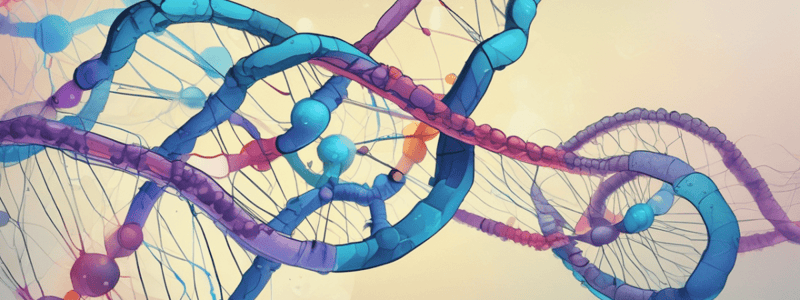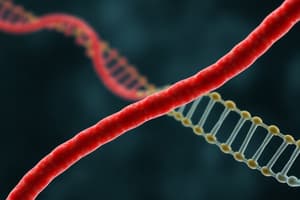Podcast
Questions and Answers
What is the role of Rho and NusA proteins during transcription?
What is the role of Rho and NusA proteins during transcription?
- To facilitate the post-transcriptional modification of RNA
- To facilitate the elongation of transcription
- To facilitate the termination of transcription (correct)
- To facilitate the initiation of transcription
What is the function of the cap added to the 5' end of the RNA transcript during post-transcriptional modification?
What is the function of the cap added to the 5' end of the RNA transcript during post-transcriptional modification?
- To stabilize the RNA and aid in translation initiation (correct)
- To facilitate the polyadenylation of the RNA transcript
- To protect the RNA from degradation and aid in translation elongation
- To facilitate the splicing of introns and exons
Which type of regulation involves the control of mRNA stability, translation, and localization?
Which type of regulation involves the control of mRNA stability, translation, and localization?
- Transcriptional regulation
- Epigenetic regulation
- Post-transcriptional regulation (correct)
- Translational regulation
What is the result of the splicing process during post-transcriptional modification?
What is the result of the splicing process during post-transcriptional modification?
Which type of regulation involves heritable changes in gene function that occur without a change in the underlying DNA sequence?
Which type of regulation involves heritable changes in gene function that occur without a change in the underlying DNA sequence?
What is the primary function of the pre-initiation complex during transcription initiation?
What is the primary function of the pre-initiation complex during transcription initiation?
During transcription elongation, what is the function of the processivity factor?
During transcription elongation, what is the function of the processivity factor?
What is the primary function of the terminator sequence during transcription termination?
What is the primary function of the terminator sequence during transcription termination?
During transcription initiation, what is the role of specific transcription factors?
During transcription initiation, what is the role of specific transcription factors?
What is the direction of RNA synthesis during transcription elongation?
What is the direction of RNA synthesis during transcription elongation?
Flashcards are hidden until you start studying
Study Notes
Initiation
- RNA polymerase II (Pol II) initiation involves the assembly of a pre-initiation complex (PIC) at the promoter region
- The PIC consists of:
- RNA Pol II
- General transcription factors (GTFs):
- TFIID (binds to the TATA box)
- TFIIA (stabilizes TFIID binding)
- TFIIB (recruits Pol II)
- TFIIE (recruits TFIIH)
- TFIIH (has kinase and helicase activities)
- The PIC is stabilized by the binding of transcription factors to specific DNA sequences
Elongation
- After initiation, Pol II escapes the promoter and begins transcribing the gene
- Elongation involves the addition of nucleotides to the growing RNA chain
- Pol II pausing and backtracking can occur, allowing for proofreading and editing of the transcript
- Elongation factors, such as P-TEFb, can stimulate transcription elongation
Transcriptional Regulation
- Transcriptional regulation involves the control of gene expression in response to cellular signals
- Regulation can occur at the initiation or elongation stages
- Transcriptional regulators, such as transcription factors, can activate or repress gene expression
- Regulation can also occur through epigenetic modifications, such as DNA methylation and histone modifications
Transcription Factors
- Transcription factors are proteins that bind to specific DNA sequences to regulate gene expression
- They can act as activators or repressors of transcription
- Transcription factors can be classified into different families based on their DNA-binding domains
- Examples of transcription factors include:
- Sp1 (binds to GC-rich regions)
- NF-κB (binds to κB sites)
- AP-1 (binds to TRE sites)
RNA Processing
- RNA processing involves the modification of the primary transcript to form mature RNA
- Steps involved in RNA processing:
- Capping: the addition of a 7-methylguanosine cap to the 5' end of the RNA
- Splicing: the removal of introns and joining of exons
- Polyadenylation: the addition of a poly(A) tail to the 3' end of the RNA
- Editing: the modification of specific nucleotides within the RNA
- RNA processing is critical for the formation of mature RNA molecules that can be translated into protein
Iniciación de la Transcripción
- La ARN Pol II se une a la región promotora, reconocida por factores de transcripción específicos.
- La región promotora se encuentra típicamente upstream del gen.
- La ARN Pol II, factores de transcripción y otras proteínas se unen para formar el complejo de pre-iniciación.
- El complejo de pre-iniciación es necesario para la iniciación de la transcripción.
Desenrollamiento del DNA
- La doble hélice del DNA se desenrolla, y la cadena template se hace disponible para la transcripción.
Elongación de la Transcripción
- La ARN Pol II lee la cadena template y empareja los nucleótidos entrantes según las reglas de emparejamiento de bases.
- El RNA se sintetiza en la dirección 5' a 3'.
- La ARN Pol II puede sintetizar largas cadenas de RNA sin disociarse de la plantilla de DNA.
- La factor de procesividad ayuda a mantener la interacción entre la ARN Pol II y la plantilla de DNA.
- La ARN Pol II puede pausar en sitios específicos en la plantilla de DNA, permitiendo la regulación de la transcripción.
Terminación de la Transcripción
- La ARN Pol II reconoce la secuencia del terminador, que es típicamente una región rica en GC.
- La secuencia del terminador señala el final de la unidad de transcripción.
- El transcrito de RNA se libera de la ARN Pol II, y la enzima se disocia de la plantilla de DNA.
- Proteínas como Rho y NusA ayudan a facilitar la terminación de la transcripción.
Modificaciones Postranscripcionales
- Un nucleótido especializado, llamado tapón, se agrega al extremo 5' del transcrito de RNA.
- El tapón ayuda a proteger el RNA de la degradación y facilita la iniciación de la traducción.
- Los intrones (regiones no codificantes) se eliminan, y los exones (regiones codificantes) se unen.
- La poliadenilación agrega una larga cadena de nucleótidos de adenina al extremo 3' del transcrito de RNA.
- Esto ayuda a estabilizar el RNA y facilita la iniciación de la traducción.
Regulación de la Expresión Génica
- La regulación de la transcripción se logra a través de la unión de factores de transcripción a secuencias de DNA específicas.
- La regulación epigenética se logra a través de cambios heredables en la función génica que ocurren sin un cambio en la secuencia de DNA subyacente.
- La regulación postranscripcional se logra a través del control de la estabilidad del mRNA, la traducción y la localización.
- Esto se logra a través de la acción de microARNs, proteínas de unión a RNA y otros mecanismos.
Studying That Suits You
Use AI to generate personalized quizzes and flashcards to suit your learning preferences.




